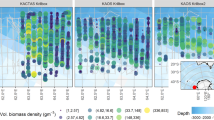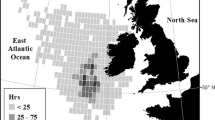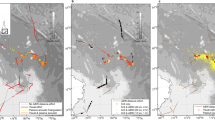Abstract
ANTARCTIC krill (Euphausia superba) is the dominant component of the diet of many whales, seals, birds, fish and squid, and their survival could be affected by a reduction in krill abundance due to fishing1. Commercial fishing takes nearly half a million tonnes of krill annually2 and accurate estimates of abundance are needed for rational management of this resource. Indirect estimates of abundance based on predator consumption rates give a roughly estimated total annual production of several hundred million tonnes3. The life-span of krill is at least two and maybe five years, so the standing stock would need to be of at least the same magnitude as the annual production. But direct estimates of abundance using nets and acoustics have indicated biomass figures lower by an order of magnitude3. Acoustic estimates are sensitive to the scaling factor or target strength (TS) used to convert echo energy to absolute abundance. Previous published values for TS (ref. 4), when applied to survey data, gave estimates of krill abundance that were much too low to account for local bird and seal predation rates near South Georgia5, and were also lower than expected when compared with density estimates from net hauls6. We therefore sought to determine TS using direct measurements developed for fish studies7, and also by applying models developed for other crustacean zooplankton8. Our results show that krill TS is much lower than previously thought, and consequently that acoustic estimates of krill abundance are likely to have been gross underestimates.
This is a preview of subscription content, access via your institution
Access options
Subscribe to this journal
Receive 51 print issues and online access
$199.00 per year
only $3.90 per issue
Buy this article
- Purchase on Springer Link
- Instant access to full article PDF
Prices may be subject to local taxes which are calculated during checkout
Similar content being viewed by others
References
Laws, R. M. Am. Sci. 73, 26–40 (1985).
Report of the Seventh Meeting of the Scientific Committee of the Commission for the Conservation of Antarctic Marine Living Resources, SC-CAMLR-VII, XXXX (CCAMLR, Hobart, 1988).
Miller, D. G. M. & Hampton, I. BIOMASS Sci. Ser. 9, (1989).
Report on Post-FIBEX Acoustic Workshop, Frankfurt, Federal Republic of Germany, BIOMASS Report Series No. 40 (1986).
Croxall, J. P., Prince, P. A. & Ricketts, C. in Antarctic Nutrient Cycles and Food Webs (ed. Siegried, W. R., Condy, P. R. & Laws, R. M.) 516–533 (Springer, Berlin, 1985).
Everson, I. & Bone, D. G. Polar Biol. 6, 83–90 (1986).
Foote, K. G. J. Acoust. Soc. Am. 73, 1932–1940 (1983).
Greenlaw, C. F. Limnol. Oceanogr. 24, 226–242 (1979).
Foote, K. G., Everson, I., Watkins, J. L. & Bone, D. G. J. Acoust. Soc. Am. 87, 16–24 (1990).
Foote, K. G., Knudsen, H. P., Vestnes, G., MacLennan, D. N. & Simmonds, E. J. Calibration of Acoustic Instruments for Fish Density Estimation: A Practical Guide (ICES, Copenhagen, 1987).
Everson, I. J. Plankton. Res. 4(1), 155–162 (1982).
Stanton, T. K. J. Acoust. Soc. Am. 83, 55–63 (1988).
Kogeler, J. W., Falk-Petersen, S., Kristensen, A., Pettersen, F. & Dalen, J. Polar Biol. 7, 231–235 (1987).
Author information
Authors and Affiliations
Rights and permissions
About this article
Cite this article
Everson, I., Watkins, J., Bone, D. et al. Implications of a new acoustic target strength for abundance estimates of Antarctic krill. Nature 345, 338–340 (1990). https://doi.org/10.1038/345338a0
Received:
Accepted:
Issue Date:
DOI: https://doi.org/10.1038/345338a0
Comments
By submitting a comment you agree to abide by our Terms and Community Guidelines. If you find something abusive or that does not comply with our terms or guidelines please flag it as inappropriate.



